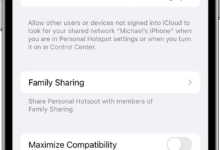The Future of Mobile Communication Technology
Contents
- 1 Hello Readers,
- 2 Introduction
- 3 The Strengths of Mobile Communication Technology
- 4 The Weaknesses of Mobile Communication Technology
- 5 Table: The Future of Mobile Communication Technology
- 6 FAQs on the Future of Mobile Communication Technology
- 6.1 1. What is 5G technology?
- 6.2 2. What are the benefits of 5G technology?
- 6.3 3. When will 5G technology be widely available?
- 6.4 4. What is 6G technology?
- 6.5 5. What are some potential applications of 6G technology?
- 6.6 6. When can we expect to see 6G technology?
- 6.7 7. What is 7G technology?
- 6.8 8. What are some potential applications of 7G technology?
- 6.9 9. When can we expect to see 7G technology?
- 6.10 10. What are the challenges facing the future of mobile communication technology?
- 6.11 11. How can we address the challenges facing the future of mobile communication technology?
- 6.12 12. What is the future of mobile communication technology?
- 6.13 13. How can I stay updated on the latest developments in mobile communication technology?
- 7 Conclusion
- 8 Closing Words
Hello Readers,
Today, we stand poised on the cusp of an exciting new era in mobile communication technology. As the world hurtles towards the dawn of 5G and beyond, it is imperative that we explore the limitless possibilities that lie ahead. In this comprehensive article, we will delve into the future of this transformative technology, examining its profound implications for our lives and laying bare the strengths and weaknesses that will shape its trajectory. Join us as we venture into the fascinating realm of mobile communication technology and dissect its profound ramifications for generations to come.
Introduction
The inexorable march of technological progress has ushered in an era where mobile communication technology has become an indispensable part of our lives. From the humble beginnings of voice calls and text messages, we have witnessed an exponential surge in the capabilities of our mobile devices. Today, they serve as gateways to a world of information, entertainment, and social connection, empowering us to stay connected with loved ones, access knowledge, and conduct business from the palm of our hands.
As we look to the future, the relentless pace of innovation promises to unlock even greater potential. The advent of 5G technology marks a watershed moment, laying the foundation for a new era of mobile communication. With its blistering speeds, ultra-low latency, and massive connectivity, 5G will revolutionize the way we live, work, and interact with the world around us.
Beyond 5G, the horizon beckons with the promise of 6G and 7G, technologies that will push the boundaries of mobile communication even further. These next-generation networks will usher in an era of ubiquitous connectivity, enabling us to connect with anything, anywhere, and at any time.
The Strengths of Mobile Communication Technology
The future of mobile communication technology holds immense promise, offering a myriad of strengths that will transform our lives in countless ways:
1. Enhanced Connectivity
The advent of 5G and beyond will shatter the barriers of connectivity, providing seamless and ubiquitous access to the internet. No longer will we be constrained by spotty coverage or sluggish speeds. Instead, we will enjoy lightning-fast connections that will enable us to stay connected with loved ones, stream content, and conduct business from anywhere, at any time.
2. Immersive Experiences
The ultra-low latency and increased bandwidth of future mobile communication technologies will pave the way for immersive experiences that were once thought impossible. Virtual reality (VR) and augmented reality (AR) will become commonplace, allowing us to interact with the digital world in ways that are both realistic and engaging.
3. Automation and Efficiency
The integration of mobile communication technology into various aspects of our lives will drive automation and efficiency to unprecedented levels. From self-driving cars to smart homes, the ability to connect devices and automate tasks will free up our time and allow us to focus on more meaningful pursuits.
The Weaknesses of Mobile Communication Technology
While the future of mobile communication technology holds immense promise, it is not without its challenges. There are certain weaknesses that need to be addressed in order to fully realize the potential of this transformative technology:
1. Security and Privacy Concerns
The increased connectivity and data sharing that comes with mobile communication technology raises legitimate concerns about security and privacy. Hackers and cybercriminals are constantly seeking to exploit vulnerabilities in these systems, putting our personal information and sensitive data at risk.
2. Digital Divide
The rapid pace of technological advancement can lead to a digital divide, where those who have access to the latest technologies reap the benefits while those who do not are left behind. Ensuring equitable access to mobile communication technology is crucial to avoid exacerbating existing inequalities.
3. Environmental Impact
The production and disposal of mobile devices, as well as the energy consumption of mobile networks, contribute to environmental degradation. It is imperative to develop sustainable practices and technologies to minimize the environmental impact of mobile communication technology.
Table: The Future of Mobile Communication Technology
| Generation | Speed | Latency | Connectivity | Applications |
|---|---|---|---|---|
| 5G | 10 Gbps | 1 ms | Massive | Enhanced mobile broadband, VR/AR, IoT |
| 6G | 100 Gbps | 0.1 ms | Ubiquitous | AI, robotics, smart cities |
| 7G | 1 Tbps | 0.01 ms | Pervasive | Quantum computing, holographic communication |
FAQs on the Future of Mobile Communication Technology
1. What is 5G technology?
5G is the fifth generation of mobile communication technology, offering significantly faster speeds, lower latency, and increased connectivity compared to previous generations.
2. What are the benefits of 5G technology?
5G technology provides a range of benefits, including enhanced mobile broadband, immersive VR/AR experiences, and support for a massive number of connected devices.
3. When will 5G technology be widely available?
The global rollout of 5G technology is underway, with many countries expected to achieve widespread coverage within the next few years.
4. What is 6G technology?
6G technology is the sixth generation of mobile communication technology, which is expected to offer even faster speeds, lower latency, and more advanced capabilities than 5G.
5. What are some potential applications of 6G technology?
6G technology could enable a range of innovative applications, including artificial intelligence, robotics, and smart cities.
6. When can we expect to see 6G technology?
6G technology is still in the early stages of development, with commercial deployment expected to begin around 2030.
7. What is 7G technology?
7G technology is the seventh generation of mobile communication technology, which is expected to offer terabit-per-second speeds and pervasive connectivity.
8. What are some potential applications of 7G technology?
7G technology could enable groundbreaking applications such as quantum computing and holographic communication.
9. When can we expect to see 7G technology?
7G technology is still in the conceptual stage, with commercial deployment not expected before 2040.
10. What are the challenges facing the future of mobile communication technology?
The future of mobile communication technology faces challenges such as security and privacy concerns, the digital divide, and the environmental impact.
11. How can we address the challenges facing the future of mobile communication technology?
Addressing the challenges facing the future of mobile communication technology requires collaboration between governments, industry leaders, and researchers to develop innovative solutions.
12. What is the future of mobile communication technology?
The future of mobile communication technology holds immense promise, with the potential to transform our lives in countless ways. By embracing innovation and addressing the challenges, we can harness the power of this transformative technology to create a better future for all.
13. How can I stay updated on the latest developments in mobile communication technology?
To stay updated on the latest developments in mobile communication technology, follow industry news, attend conferences, and subscribe to relevant online resources.
Conclusion
The future of mobile communication technology is a tapestry of infinite possibilities, poised to revolutionize the way we interact with the world around us. As we delve deeper into the realm of 5G and beyond, we must embrace the strengths and confront the weaknesses of this transformative technology. By addressing the challenges and harnessing the potential, we can shape the future of mobile communication technology to create a society that is more connected, more efficient, and more equitable for all.
The journey ahead is filled with both promise and peril. By working together, we can navigate the challenges and unlock the limitless potential of mobile communication technology. Let us embrace the future with optimism and determination, ensuring that this transformative force becomes a catalyst for progress and a beacon of hope for generations to come.
In the ever-evolving landscape of mobile communication technology, it is essential to stay informed and engaged. By continuously learning and adapting, we can become active participants in shaping the future of this transformative technology. The possibilities are endless. Let us embrace the journey and unlock the limitless potential that lies ahead.
Closing Words
As we stand on the cusp of a new era in mobile communication technology, it is important to remember that the future is ours to create. By embracing innovation, addressing challenges, and working together, we can harness the power of this transformative technology to build a world






